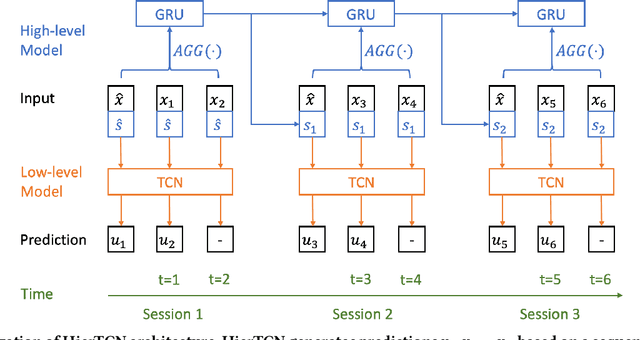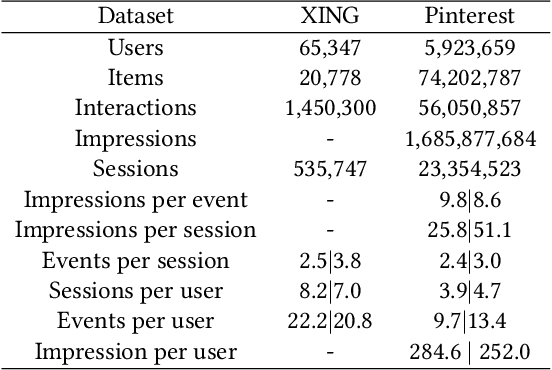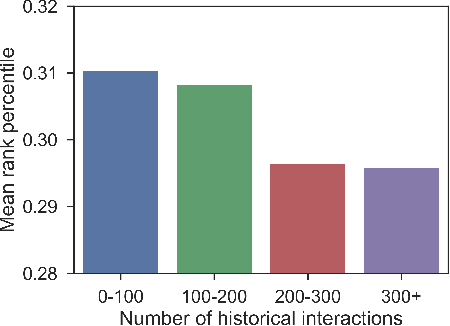Pong Eksombatchai
TransAct: Transformer-based Realtime User Action Model for Recommendation at Pinterest
May 31, 2023Abstract:Sequential models that encode user activity for next action prediction have become a popular design choice for building web-scale personalized recommendation systems. Traditional methods of sequential recommendation either utilize end-to-end learning on realtime user actions, or learn user representations separately in an offline batch-generated manner. This paper (1) presents Pinterest's ranking architecture for Homefeed, our personalized recommendation product and the largest engagement surface; (2) proposes TransAct, a sequential model that extracts users' short-term preferences from their realtime activities; (3) describes our hybrid approach to ranking, which combines end-to-end sequential modeling via TransAct with batch-generated user embeddings. The hybrid approach allows us to combine the advantages of responsiveness from learning directly on realtime user activity with the cost-effectiveness of batch user representations learned over a longer time period. We describe the results of ablation studies, the challenges we faced during productionization, and the outcome of an online A/B experiment, which validates the effectiveness of our hybrid ranking model. We further demonstrate the effectiveness of TransAct on other surfaces such as contextual recommendations and search. Our model has been deployed to production in Homefeed, Related Pins, Notifications, and Search at Pinterest.
Hierarchical Temporal Convolutional Networks for Dynamic Recommender Systems
Apr 10, 2019



Abstract:Recommender systems that can learn from cross-session data to dynamically predict the next item a user will choose are crucial for online platforms. However, existing approaches often use out-of-the-box sequence models which are limited by speed and memory consumption, are often infeasible for production environments, and usually do not incorporate cross-session information, which is crucial for effective recommendations. Here we propose Hierarchical Temporal Convolutional Networks (HierTCN), a hierarchical deep learning architecture that makes dynamic recommendations based on users' sequential multi-session interactions with items. HierTCN is designed for web-scale systems with billions of items and hundreds of millions of users. It consists of two levels of models: The high-level model uses Recurrent Neural Networks (RNN) to aggregate users' evolving long-term interests across different sessions, while the low-level model is implemented with Temporal Convolutional Networks (TCN), utilizing both the long-term interests and the short-term interactions within sessions to predict the next interaction. We conduct extensive experiments on a public XING dataset and a large-scale Pinterest dataset that contains 6 million users with 1.6 billion interactions. We show that HierTCN is 2.5x faster than RNN-based models and uses 90% less data memory compared to TCN-based models. We further develop an effective data caching scheme and a queue-based mini-batch generator, enabling our model to be trained within 24 hours on a single GPU. Our model consistently outperforms state-of-the-art dynamic recommendation methods, with up to 18% improvement in recall and 10% in mean reciprocal rank.
Graph Convolutional Neural Networks for Web-Scale Recommender Systems
Jun 06, 2018



Abstract:Recent advancements in deep neural networks for graph-structured data have led to state-of-the-art performance on recommender system benchmarks. However, making these methods practical and scalable to web-scale recommendation tasks with billions of items and hundreds of millions of users remains a challenge. Here we describe a large-scale deep recommendation engine that we developed and deployed at Pinterest. We develop a data-efficient Graph Convolutional Network (GCN) algorithm PinSage, which combines efficient random walks and graph convolutions to generate embeddings of nodes (i.e., items) that incorporate both graph structure as well as node feature information. Compared to prior GCN approaches, we develop a novel method based on highly efficient random walks to structure the convolutions and design a novel training strategy that relies on harder-and-harder training examples to improve robustness and convergence of the model. We also develop an efficient MapReduce model inference algorithm to generate embeddings using a trained model. We deploy PinSage at Pinterest and train it on 7.5 billion examples on a graph with 3 billion nodes representing pins and boards, and 18 billion edges. According to offline metrics, user studies and A/B tests, PinSage generates higher-quality recommendations than comparable deep learning and graph-based alternatives. To our knowledge, this is the largest application of deep graph embeddings to date and paves the way for a new generation of web-scale recommender systems based on graph convolutional architectures.
 Add to Chrome
Add to Chrome Add to Firefox
Add to Firefox Add to Edge
Add to Edge